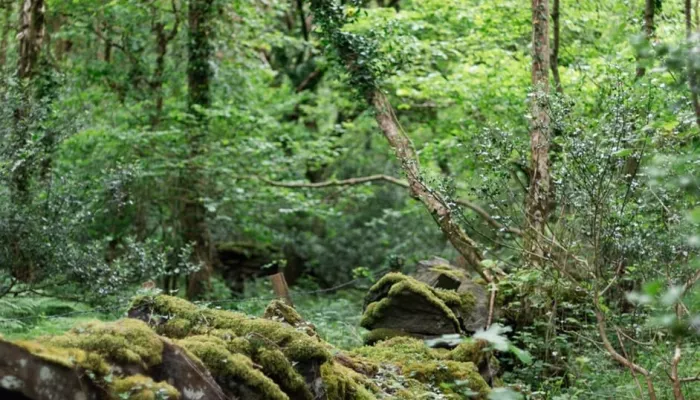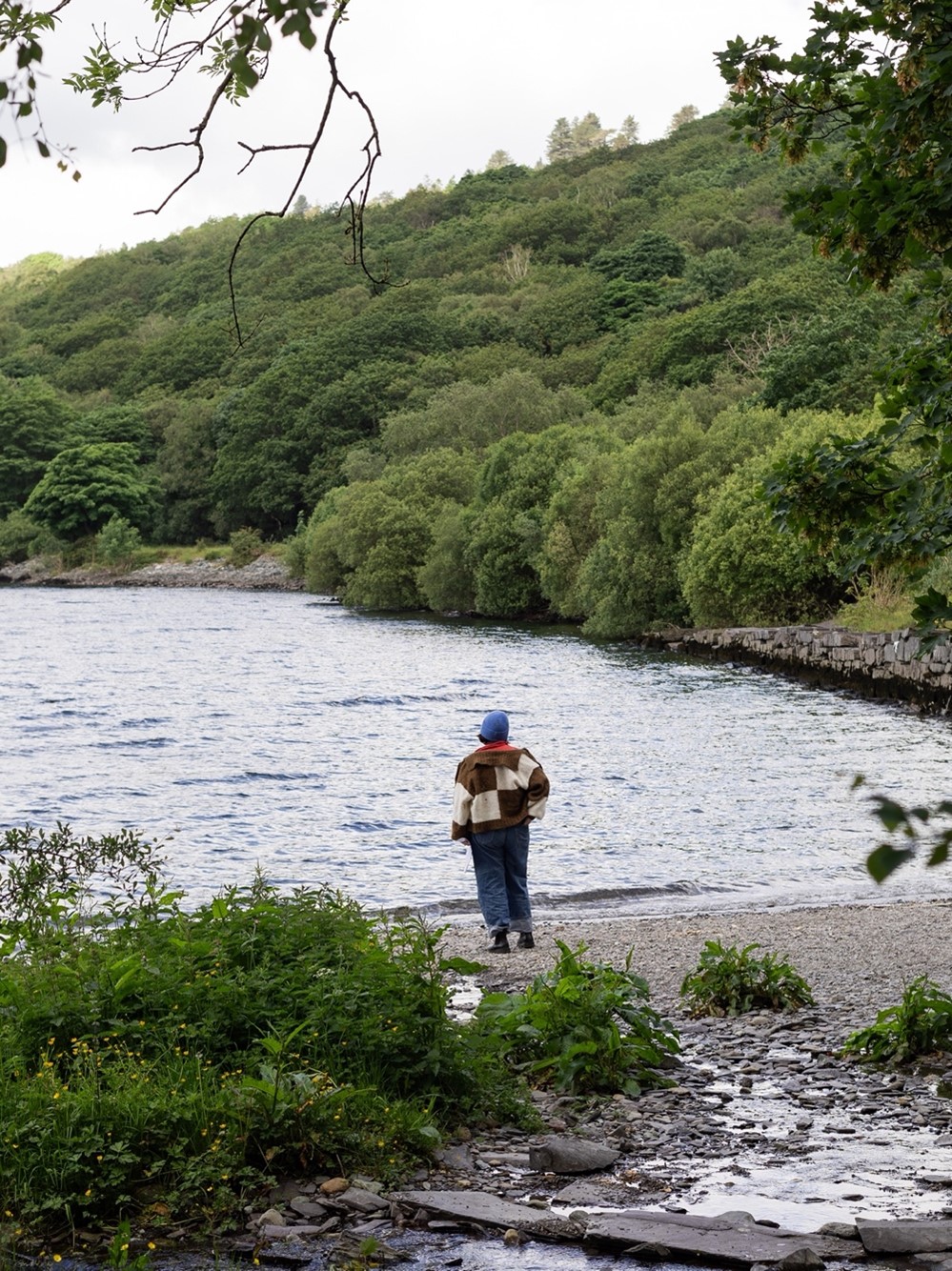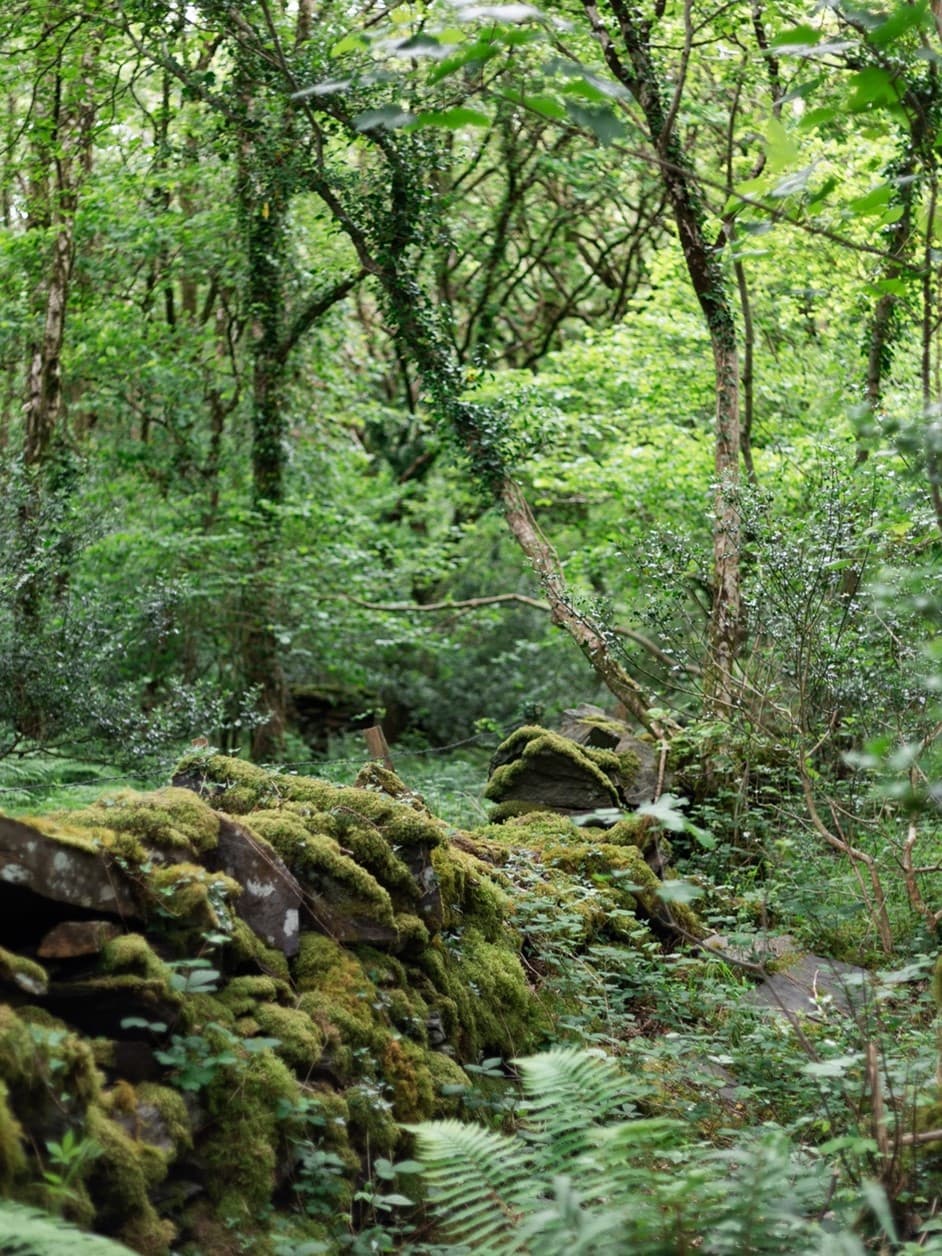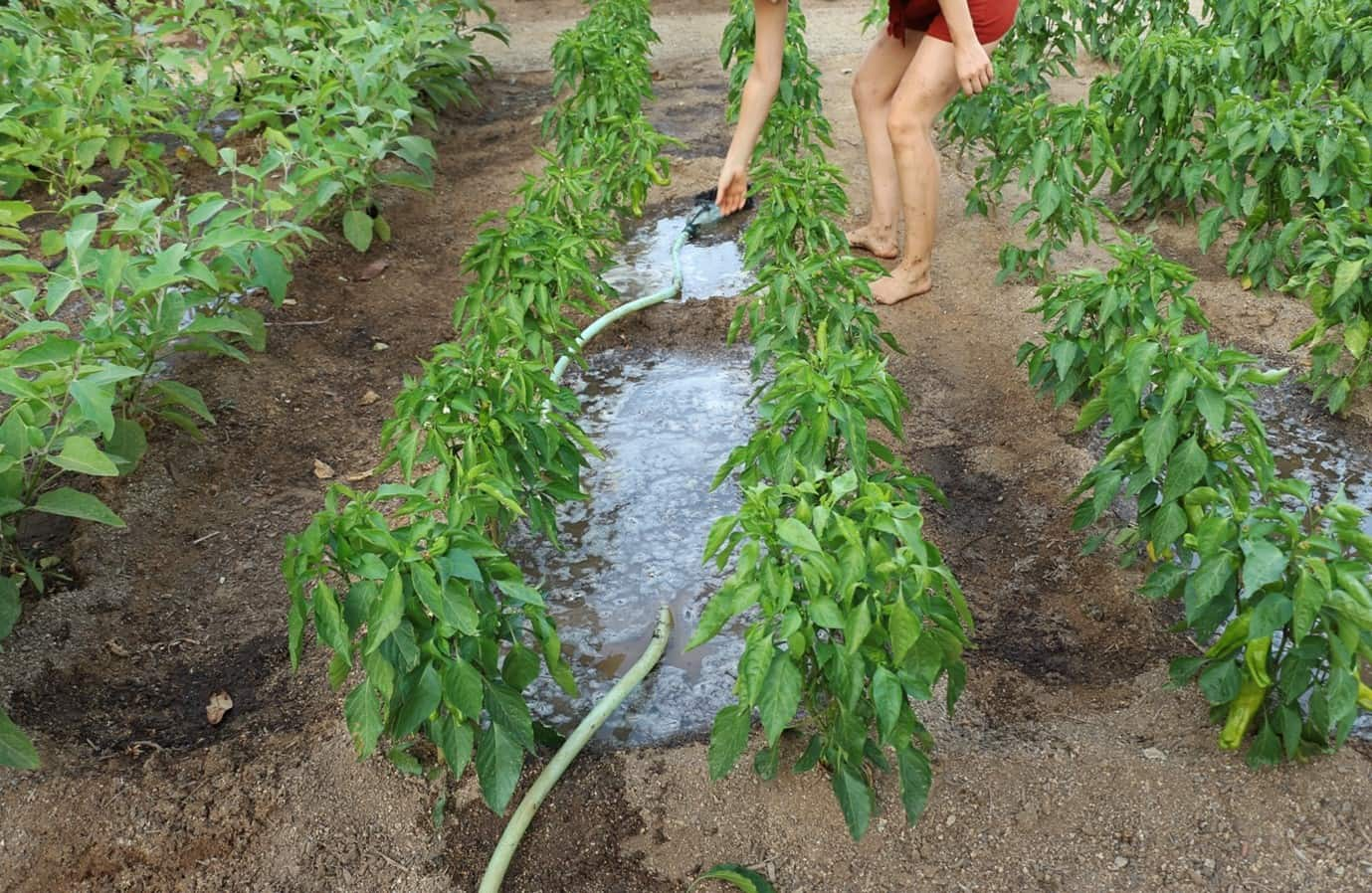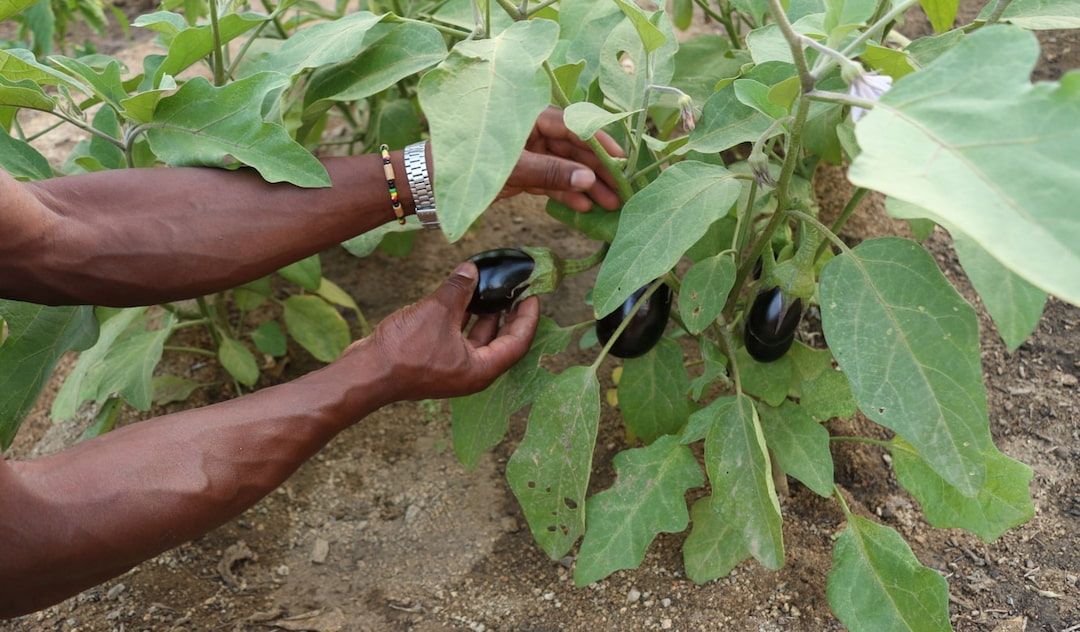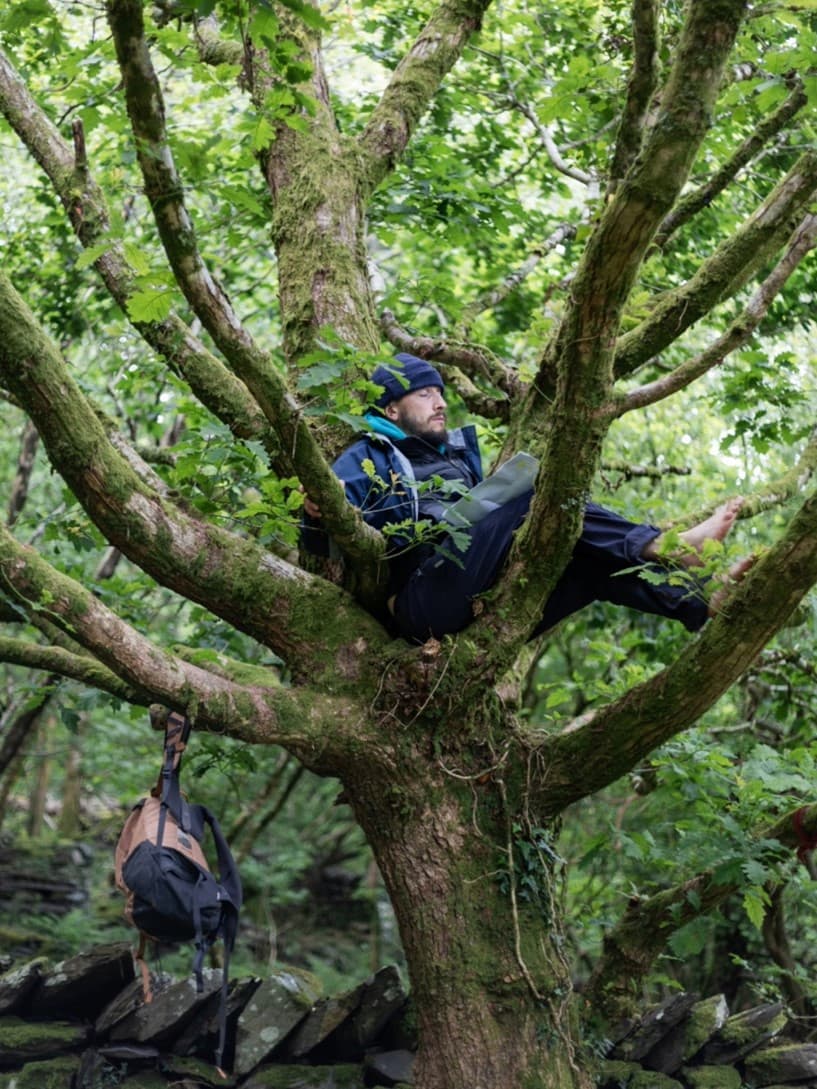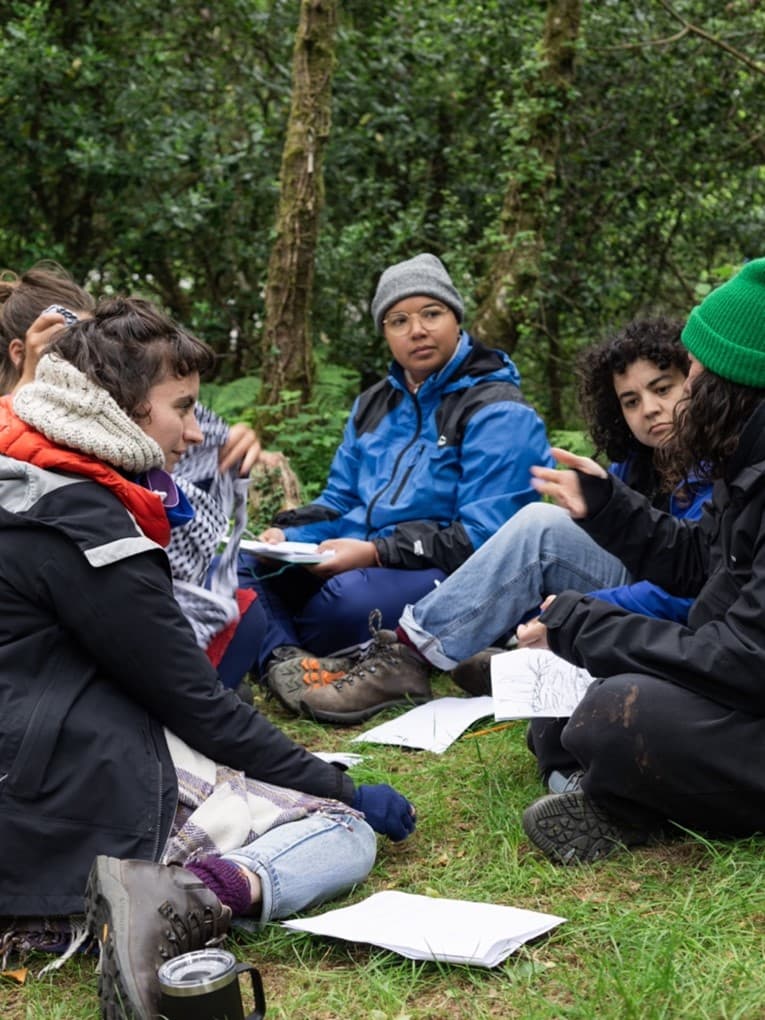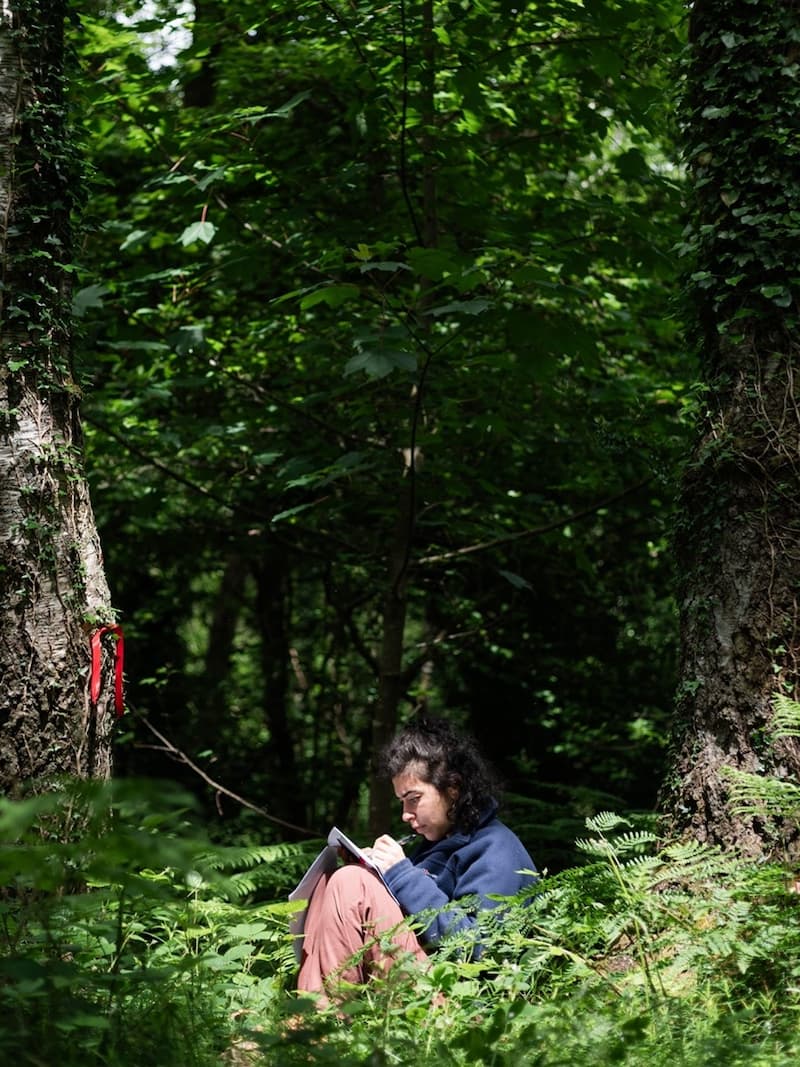By the end of the two hours, it was clear that both Jacob and Rae did sustain intense, emotional relations to the environment. Jacob is preparing a second event to raise awareness about light pollution at night, where large proportions of light are switched off to allow people to appreciate the night sky in urban centres. Urban light can greatly disrupt the life cycles of animals, who might depend on darkness to hunt or reproduce. Rae felt a strong pull towards ‘unwanted plants’: wild plants often deemed weeds or invasive. Rae tried to alter their often negative depiction through their art practice, helping to build appreciation of so called ‘weeds’ that are often crucial habitats for billions of insects and microbes(1).
1 Both workshop participants consented to me writing about them. Rae is a pseudonym.
Figure 1: unless specified, all photos in this article are taken by Tal (Instagram - @taltakingpics). The photos are from a workshop I ran for Miknaf Haaretz in Snowdonia this summer.
Our relations to the environment are complex. Messy. We can be both disconnected and connected, can feel like we are ‘divided’ from nature as humans yet sustain relations with species that are reciprocal or function like kin-relations(2). Sometimes it takes sitting down and talking about the environment - or sensing it with our bodies - to unravel these buried threads and see more clearly what our connection with nature is, and more importantly, how this relationship could change in the future. This post will walk you through my immersive workshops, as they hope to provide a space where participants can navigate their relation to the environment. We will do this from a bird’s eye view, exploring the contemporary urban relations to the environment that these sessions hope to disrupt.
Growing & running my nature immersion workshops
For the past four years, I’ve run immersive workshops for different audiences. We meet up for two hours, talk, walk, draw, smell, touch, and reflect. The sessions aim to provide tools for attendees to navigate and understand their relationship to the non-human worlds around them. Such a reorientation might shift one’s relation to nature, perhaps deepening it or adding more critical angles from which to understand the environment. Of course, the workshop’s effects depends on the participants’ own journey as opposed to anything the session itself could hope to give. I strongly believe that critically connecting to the environment is enriched through using our five senses, distancing us from a model of education too centred on speech and text. The Potawatomi(3) scientist Robin Wall Kimmerer reminds us that the plants are also our teachers and we should distance environmental education from the criteria of objectivity and emotional distance often written into conventional scientific methods.(4)
2 Someone with whom you are or feel related to. Kin relations can be formed in many ways, such as through descent or marriage. In some cultures, plants are kin to humans, as written about by the anthropologist Sophie Chao.
3 The Potawatomi are a Native American people of the Great Plains, upper Mississippi River, and western Great Lakes region of North America.
4 Please email me ([email protected]) if you can not easily access any of the books/ articles referenced in this post. I can try and get them to you.
These workshops are also informed by the many people I met during my doctoral research. For the past four years, within the discipline of anthropology(5), I’ve been researching the growth of alternative green spaces in the city of Barcelona, Catalonia. These may be urban food gardens or leafy spaces that hope to encourage biodiversity. These oases are often set up “illegally” as squats by grassroots actors, transforming abandoned buildings or empty government land. There are legal risks involved in this process and huge amount of manual labour involved in ‘greening’ the city from below. Through volunteering in these spaces and interviewing my research participants, I came to realise that if we wanted to understand why these people were motivated to alter the city’s relation to the environment, it was important to understand their own relations to the environment. How they defined ‘nature’, ‘humans’, their ethical obligations to non-humans. For many of them, their relations had shifted from their earlier lives, partly triggered by the advent of the climate crisis in Spain, from fatal overheating in cities to repeated droughts. For many, it was spending time amongst the plants and insects of the gardens that transformed them.
5 Anthropology is a social science and as a discipline, it strives to understand human society and culture in all its diversity and complexity.
In these green spaces, thousands of citizens would enter, pause, and reflect or ‘feel their way’ towards the environment, often asking questions otherwise silent in the hustle and bustle of urban life: what do I already know about the environment and what more can I learn? How do I go about learning this? Do I feel ethically obliged to care for the environment? Then there were the connections that visitors made to non-humans. People communicated with mammals, from cats to birds. They formed emotional bonds with plants, the soil. These green spaces were a sensorial pause in their often human dominated lives. This catalysing pause, which some people experienced during the Covid pandemic, led to a deepening of their relation to the environment.
My workshops are offered in this spirit, hoping to create a safe and embodied space to feel, smell, taste, walk, see our relations to the environment. To make the familiar strange, as anthropologists often hope to do. The more active and emotional, sensorial and exciting our relation is to the environment, the more it becomes something we actively want to care for or address. At least I have found this to be the case over and over again in my own research.
But let’s get specific - what could these navigation tools actually look like? The workshop is split into two halves, each focusing on a distinct realm of human-environment connections.
One: knowing with the body
In the world, there are countless different methods or traditions for acquiring knowledge. Each tradition is equipped with their own tools for learning about phenomena – from oral history passed through generations, to imitating one’s elders as a means to learn, to assessing cell structure under a microscope. The tools with which we know about the environment also build a specific relationship with the being or thing being known. A horse whisperer will have a different relation with a horse to someone studying horse genetics in a lab. Many of us who live in post-industrial cities and work in human-facing jobs do not have much time or space to cultivate knowledge in understanding and sensing the environment – at least outside of reading about it in the media.
Let’s briefly explore why this might be. Instead of going outside to learn how cows gave birth or how to coppice forests, as was more common in Europe prior to the Industrial Revolution, it is often more accessible to read, watch or listen to accounts about the climate through the media. We may have a great literacy around the climate, but we are often not pushed to go and learn about the environment through our senses (smell, taste, touch). In primary school education, as found in the context of Germany(6), there is also often a tendency to teach the environment indoors through text and abstract representations, instead of through ‘primary experience’, such as being outdoors. Education research suggests that for children, text heavy and overly ‘objective’ education around the climate leads them to care or connect less to the outdoors. There is however much more outdoors nature education for children than for adults, despite the growth of citizen science initiatives. As adults, reading about species extinction is different from being struck by the silence of a forest that used to ring with bird song or the hum of insects.
Some of us who might feel disconnected from the environment because, as Kimmerer states, ‘science has cornered the market on truth’. Despite the existence of multiple knowledge traditions that shed light on the environment, we can often assume that one needs to be a scientist or ecologist, with requisite tools and training, to possibly ‘know’ about the environment in depth. It’s the specialists that actively create knowledge about the environment around them, not us. Today, and in the past, many communities ‘knew’ deeply about the environment using knowledge systems that would not be valid according to scientific standards, such as understanding how to live sustainably from an ecosystem, learnt through centuries of touch and observation, as well as through spiritual and shamanistic mediums. The vast amount of common names for plants that specified their medicinal use (“feverfew”, “knitbone”) or English weather lore indicates how widespread environmental deductions used to be:
Sea gull, sea gull, sit on the sand,
It’s never good weather when you’re on the land.
An aim of the workshop is to present an array of tools for ‘knowing’ the environment in a sensory and embodied way. I believe that this form of knowledge, where we can walk into a woods and ‘sense’ multiple processes in the world around us simply by using smell or sight, can build a closer emotional and knowledge-based connection with the natural world. A confidence that you too can create new knowledge. Some of these tools are taken from ecologists who hope to make their findings more accessible, such as Kimmerer’s instructions as to how to sense the micro-climate of a forest through the relative height of moss. Other tools in the workshop guides draw from different knowledge traditions not found in conventional scientific methodologies, such as exploring whether we feel we can communicate with non-humans or how we think of animacy(7) in the natural world. With this in mind, I give each workshop attendee a written guide to follow alone. The point is to choose a one or two tools from about eight, read about them and then put them into practise them through the body. Reading can be a springboard to a more sensory relation, as opposed to replacing the senses.
I hope attendees feel they can make use of such tools made distant to them. The functional value of this knowledge is also something we communally explore in the workshop. If one wanted to, they could develop their ability to assess tree diseases and become a local tree warden. In other instances, they could learn how to assess the health of river life and know when a pesticide laden field was too close to it(8). With knowledge, perhaps, comes proximity. Especially if that knowledge springs from our noses, feet and hands, sniffs and touches, mingled with the awe and wonder that can accompany our outdoors explorations(9). Honing these skills can also mean physically spending time outdoors, learning how to fine-tune smelling, how to see details otherwise concealed, how to touch with nuance. It has been shown that if humans use their nose enough, they can distinguish between two nearly identical molecules. These knowledge journeys might also cultivate wellbeing, whether because we often feel less stressed when seeing green or because we are exposed to the healing anti-oxidants exuded by trees.
Two: Introspection
There are around 12 million pet dogs in the UK (more than pet cats, but it’s not a competition). For many dog owners, their panting-barking-tail-chasing-companions are incredibly active part of their lives. A dog owner might know exactly how they define their relation to a dog, whether that be as an “owner”, “guardian” or family member. Through reflection or discussion with others, you may be fairly clear on your duties to that dog: I have to care for them, walk them, feed them, love them. This relationship may be reciprocal: I hope for affection or good behaviour from my dog, but in return I have to care for my dog and show them affection. The merging of these behaviours combines to give your relationship (owner, friend, family) legitimacy and weight. It may be a conditional relationship, based on these continued mutual actions. This is an active and complex relation to a nonhuman being, similar to relations with humans. Active in the sense that they often feature in your daily decisions and bear weight upon how you navigate the world, and complex in the sense that you have multiple terms that define your relationship, your ethical obligations, your mutual duties to each other. It is also your dog who shapes this relation, teaching you what they need and how they navigate the world, expressed in the way they look at you, socialise with you, communicate their needs.
6 Nature experience and its importance for environmental knowledge, values and action: recent German empirical contributions. Susanne Bögeholz*Göttingen University, Germany.
7 A term often denoting animate, alive or conscious beings.
8 Taking a wide-angle perspective, caring for local ecosystems has to be balanced with direct action that addresses the large-scale exploitation of non-renewable energy resources that has damaged the global ecosystem. One might be drawn to get involved in movement such as Extinction Rebellion that have this broader agenda, placing pressure on governments and corporations to change course.
9 Of course, with the acceleration of the climate crisis, many people’s relation to the environment is associated with destruction, violence, and danger.
This active, complex relation to non-humans exists in different ways for different communities. In diverse cultural contexts, the species, or entire landscapes, that we bear active relations with can change drastically. Human-dog relations might phase into the background, replaced by entire mountains, herds of sheep, Himalayan ice caps, camels, desert lagoons, your local park, the Atlantic coast, tropical forests. To give you an example that is closer to my doctoral research, some of my participants grew up in rural, non-industrial villages in Spain’s interior. A few of these villages were ‘commons’. They were communally owned by the villagers, meaning all produce from the land was cultivated together and equally shared. Countless species, farming methods and weather conditions were involved in surviving, from knowing how to put limits on sheep grazing so as not to compact the soil to coppicing oak trees in a sustainable way.
My friend Jaxi’s village had weekly meetings where such matters were discussed. These assemblies were woven through with ethics, definitions of the land, defined relationships. For example, people knew that for the local ecosystem to be healthy, they had to not over-fell trees or over graze the grass close to trees. There were sustainable and also communal destructive ways one could interact with the forest, and laws that qualified such behaviours were defined and debated. In a different context, such as for Indigenous Marind communities in West Papua, those who live in the Upper Bian forest refer to many plants and animals as their kin, often using the term amai. As the anthropologists Sophie Chao explains, ‘amai grow to support their human kin by providing them food and other resources’. In return, ‘humans must exercise respect and perform rituals as they encounter amai in the forest’. For many Marind, part of being good kin to the forest is maintaining a degree of wildness (liar) in the plants that they encourage to grow, leading to a less intensive form of food cultivation that supports the overall health of the forest.
As in the above two cases, in talking and reflecting on the multitude of non-human worlds around us, we keep them present and alive. In doing this communally, we get used to their presence in our social worlds, their importance and their existence. Yet we are perhaps not very used to sitting down and untangling our relations to nature, especially in front of other people. The nuanced environmental vocabulary many of our ancestors had is slipping from our collective memory(10). As explored above, there are many reasons for this, such as the way urban infrastructures and long supply chains create less interactive relations between us and the ecosystems we survive from. Sometimes we might be weary of being labelled a ‘tree hugger’ (although being a tree hugger is a compliment if you know where the term comes from(11)). The environment might feel far for other reasons, such the threat of racist violence making the countryside inhospitable for many ethnic minorities in the UK.
In the workshop, we’ve debated whether: trees are alive; how we can communicate to non-humans; shared our notion of ‘wilderness’ or ‘domesticated’ landscapes, our ethical relations to our local park or the global ecosystem. The hope is that this can help to clarify and activate internal and communal relations to the environment. This process might make you realise just how much you do care or connect with your closest forest, and encourage a shifted relation to it. Perhaps you might cultivate reciprocity, where you find ways to care for it, in return for all it gives you. Memories of ancestors are often very present in this part of the workshop. The environmental lessons of grandparents come back to attendees, awoken by smells or tactile sensations, bursting into the present with a heavy emotional presence.
The more we talk through these complex relations, the more we may get used to the presence of animals (plants, microbes, fungi, water cycles, sediments…) in our lives. If you live in London, you most likely walk around with the Thames water inside of you, sloshing around your stomach, sustaining your cells. Giving voice or simple terms to such relations can highlight our existing entanglements, the depth of our feelings, potential future relationships. Putting voice to these might lessen Jacob or Rae’s feelings that they are ‘disconnected’ from nature. Sometimes often repeated narratives about modern urban life can silence the multi layered complexities that already exist. As Ailton Krenak, the indigenous rights activist, writes, ‘We were led to think that Earth is one thing and that we are another. My perception is that there isn’t anything that isn’t nature. Everything is nature’.
10 Language deeply shapes how we are able to perceive the world. It has been shown that ‘people who speak a language that has multiple words for different shades of color perceive the shades more quickly’.
11 “The term “tree hugger” was first coined 1730, when 294 men and 69 women of the Bishnois branch of Hinduism, physically clung, or “hugged” the trees in their village in order to prevent them from being used to build a palace. These “tree huggers” were then killed by the foresters cutting down the trees”. See here for quote source.
A huge thank you to Flora for this comprehensive and fascinating guest blog! More about Flora can be found on her website below, including information about past projects and upcoming events.

